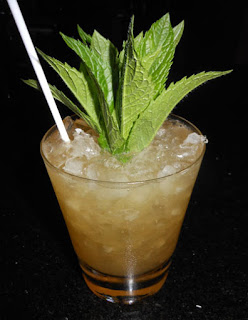1 1/2 oz Beefeater Gin
3/4 oz Raspberry Syrup (*)
1/2 oz Lime Juice
Build in a Highball glass filled with ice. Stir to mix and top with ginger ale. Garnish with a lime wedge and add a straw.
(*) Green Street's raspberry syrup is only lightly sweetened and less sugary than a 1:1 simple syrup. Perhaps with a sweeter raspberry syrup, a 1/2 oz would be better here.

After Brick and Mortar, we crossed Mass Ave and paid a visit to Green Street Grill. There, bartenders Derric Crothers and Philip MacLeod were presiding over yet another Stout Sunday. Instead of beer, I asked Derric for the Florodora. The name makes reference to the Florodora Girls who were six singing and dancing ladies who started in London in 1899 before moving to Broadway in 1900. Over seventy girls who fit the specification of being 5 foot 4 inches tall and 130 pounds filled the spots over the years; since these pretty and petite girls were the object of much adoration, much of the attrition was due to male admirers, often rather wealthy, who persuaded them to leave the show. In fact, each of the original sextet snared a millionaire. As David Wondrich relates in
Imbibe!, the drink was created one night after a performance. One of the sextet refused anything except for lemonade, unless it was something brand new created for her. Jimmy O'Brien was cited by the
New York Evening World as the barman who created this Highball for her in 1901.

The Florodora's bright hue did not contradict its gin and fruit aroma. The carbonated lime sip was followed by gin and ginger flavors on the swallow. Moreover, the raspberry appeared as a lingering tangy note on the finish. Even with the color, it was still not the most femme looking drink I have had at Green Street; those honors go to the frothy, pink, and delicious
Clover Club also made with their raspberry syrup. After the Florodora, I returned to an old favorite, the
New York Flip, and updated the writeup with a photograph.


















































 The 2017 collection of 855 drink recipes, bartender tributes, and essays on hospitality from CocktailVirgin's Frederic Yarm. Available at
The 2017 collection of 855 drink recipes, bartender tributes, and essays on hospitality from CocktailVirgin's Frederic Yarm. Available at  The 2012 collection of 505 drink recipes, techniques, and Boston bar recommendations from Frederic Yarm. Available at
The 2012 collection of 505 drink recipes, techniques, and Boston bar recommendations from Frederic Yarm. Available at 




